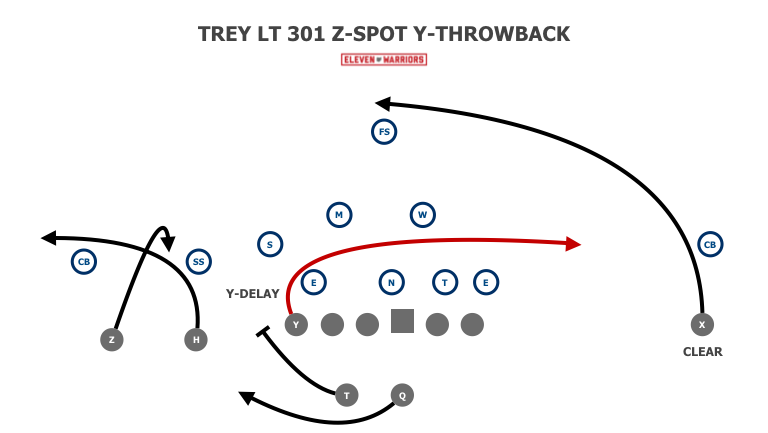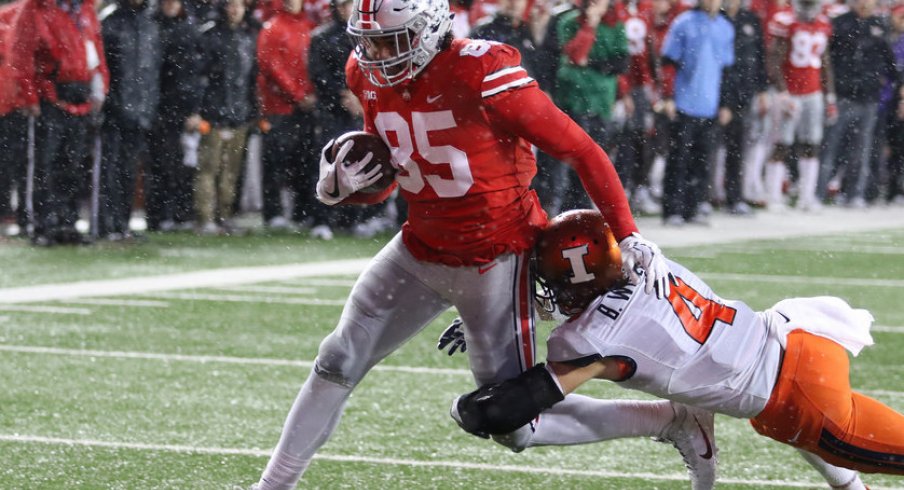Three-star in-state linebacker CJ Sanna commits to Ohio State.
There are two ways to prepare for a rivalry game.
The first, and most common, approach is to hold all your best cards until the day of the big game, coming out with new wrinkles no one has seen before and leaving your opponents on their heels as they try to decipher what is happening on the fly. This was often the model under former Ohio State head coach Jim Tressel, he of the 9-1 record against his biggest rival and the architect of the victory in 2006 in which his top-ranked Buckeyes defeated their second-ranked opponents.
Though Tressel had long been considered a 'conservative' play-caller and featured two NFL running backs, he opened up that famous contest with a five-wide receiver look and slung the ball around all afternoon to the tune of 316 passing yards against one of the nation's top defenses. It certainly didn't hurt that the eventual Heisman Trophy winner was in the pocket throwing to a group of receivers that would amass 831 professional catches (and counting), and such a shock to their opponents' system had the desired effect.
But the straight-laced leader was known to spend all season preparing for The Game, installing special wrinkles that would give the scarlet and gray the upper hand. His eventual successor, Urban Meyer, hasn't always gone to the same extreme in terms of specific preparations for one game but has been known to debut new gadgets in past tilts with the team from Ann Arbor.
This year, however, Meyer seems to be taking the second approach. With a new offensive brain trust of Kevin Wilson, Ryan Day, and increasingly, line coach Greg Studrawa building the game plan each week, the Buckeyes have embraced a 'less is more' attitude this fall. While Meyer's teams in Columbus have long been known for their diversity in the running game, teaching virtually every concept found in a pro playbook, this year, they've dialed back the complexity.
Similarly, to reignite a stagnant passing game, Day has leaned heavily on two core passing concepts: Rams Mesh (named for Mike Martz and the Greatest Show on Turf St Louis Rams) and Bubble Y-Over (aka Saints). While having just two central plays may seem predictable, the trio has done an excellent job of using diversity in their formations to keep defenses from anticipating their calls.
But against a defense like the one they'll see this Saturday, the Buckeyes can't simply rely on a unique alignment to keep the wolves at bay. Don Brown teaches an aggressive brand of football that asks a lot of his players but gets the results many coaches only dream of. So, to keep Brown, his staff, and their players from picking up on any kind of tendencies or keys that might alert them to a certain play-call, the Buckeyes emptied the playbook last weekend in their 52-14 drubbing of Illinois.
Against Michigan State the week prior, Ohio State's offense looked unstoppable thanks to some subtle tweaks in their alignments that left the Spartans grasping for answers. Primarily, an unbalanced set placed all three wide receivers and the tight end to the wide side of the field created all kinds of havoc for the defense as they looked to defend each gap against the powerful Buckeye running game.
Instead of putting that successful approach back on the shelf for a week and hoping no one up north would remember it even existed, Meyer and his staff doubled down, showing even more looks from this formation. The first, and most noticeable, was a reverse to 'H' receiver Parris Campbell, who took a lateral from running back Mike Weber back across the grain of the play and turned upfield before leaving several Illini defenders grasping at thin air.
After hitting the reverse for a big gain and methodically running the ball from this set, the Buckeyes called for a regular Trips formation that still caused confusion for the defense. With three receivers split wide to one side, the Illini thought they had every gap covered thanks to a wrinkle of their own that saw both outside linebackers align over the wide D-gaps.
But with the tight end to the right, the line shifted over too far when executing their called slant after the snap, leaving an extra gap for the middle linebacker to cover. As the MIKE tries to get outside with Weber, he allows a huge cutback lane and offers the sophomore runner only the slightest of arm tackles, allowing him to race 42 yards to the end zone instead.
Even when initially lined up in the kind of balanced look you'd normally expect from a Meyer offense, the Buckeyes used motion to tip the scales in their favor. Tight end Marcus Baugh shifted before quarterback J.T. Barrett began barking his cadence, while fellow "H' K.J. Hill came in Jet motion across the formation.
The Buckeyes would execute a true Jet sweep with Campbell in this game, just to keep the defense honest, but the real reason was to set up this concept: a relief pass giving Barrett the option to either throw or run for himself after making his read to keep or give on an inside handoff. Though the play goes down as a pass, it's built in as a core piece of the Buckeye running game, essentially acting as a long outside run.
While the Buckeyes haven't executed a run-pass option quite like this before, it should still look familiar. Baker Mayfield and the Oklahoma Sooners perfectly executed their version of this exact same concept in their week two victory in Ohio Stadium and seemed to inspire Meyer's offensive staff in the process.
The unbalanced set wasn't the only new formation shown against the Spartans that made its way into the Illinois call sheet, though. A new, compressed alignment for the 'H' inserted the slot receiver into the Buckeye running game as an additional blocker, sealing interior defenders from getting outside and helping to spring the runner, as we saw from this variation of the 'Power-Read' concept.
Again, the play above may not seem like anything unusual, as J.T. Barrett has executed this play countless times in his four years under center. But for Don Brown, it creates static in the signal, as it not only shows the play can be run from a different formation, but that the offense can pull the center instead of a guard as the lead blocker, and that the offense can leave the end unblocked for the QB to read instead of the middle linebacker, as we saw when Barrett owned the fourth quarter and overtime in last year's rivalry game.
The Buckeyes didn't forget about covering their tracks in the passing game, either. As they have all season, Wilson and Day showed they could execute their Rams Mesh concept from any alignment, hitting it on back-to-back snaps at the end of the first quarter from both the Trips look and with the 'H' lined up inside.
Although the Illini showed some of the famous Tampa 2 defense that helped launch Lovie Smith's career in the NFL, they often lined up in man-coverage, something the Buckeyes will see quite often in their trip up north. Perhaps to show they aren't scared, or maybe to get live, game reps against a real opponent, the Buckeyes unveiled a few 'man-beater' concepts designed to free up receivers against such coverage.
But everyone loves a trick play, and had it not been for a shaky start to the second half from Dwayne Haskins and the backup offense, we may have never seen one last weekend. Once reinserted in the game, Barrett and the starters benefited from a fumbled punt return and were set up with excellent field position yet again.
Instead of just pounding the ball in the rainy conditions as they had prior to the punt, Meyer and his staff purposefully showed their hand, unveiling a wrinkle not yet seen from their offense.

Building off the Spot concept that frees up the 'H' against man coverage in short yardage by setting a pick from the 'Z' receiver, the Buckeyes knew tight end Marcus Baugh would get lost in traffic and would be left wide open as his defender (the middle linebacker) sprints to get outside to keep Barrett from running. 'Z' receiver Jonnie Dixon was so confident in the play's outcome that he raised his arm to signal the touchdown before the ball had even arrived in Baugh's hands.

Though Penn State had success against the Wolverines by taking the opposite tack - showing new formations and concepts that forced Brown to get even more aggressive and lose fundamental stability - the Buckeyes clearly feel they have a better chance of beating their rivals by showing everything they've got beforehand.
Just as the Buckeyes keep an eye on their rivals all year long, the opposition undoubtedly does the same and has charted every single snap J.T. Barrett has taken in his Buckeye career. But the insertion of all these new formations and concepts are designed to create noise in the receiver and keep Don Brown and the Michigan defense from identifying what the Buckeyes want to do before they get the chance to do it.
But just because it might seem as though the Buckeyes have shown all their cards leading up to The Game, it doesn't mean they don't have another ace still hidden up their sleeves.



